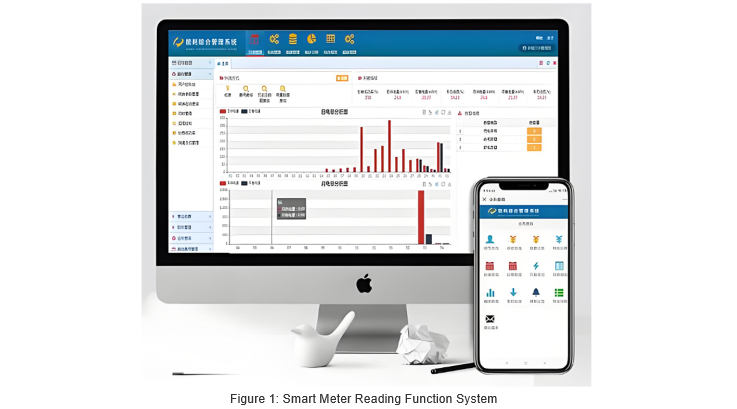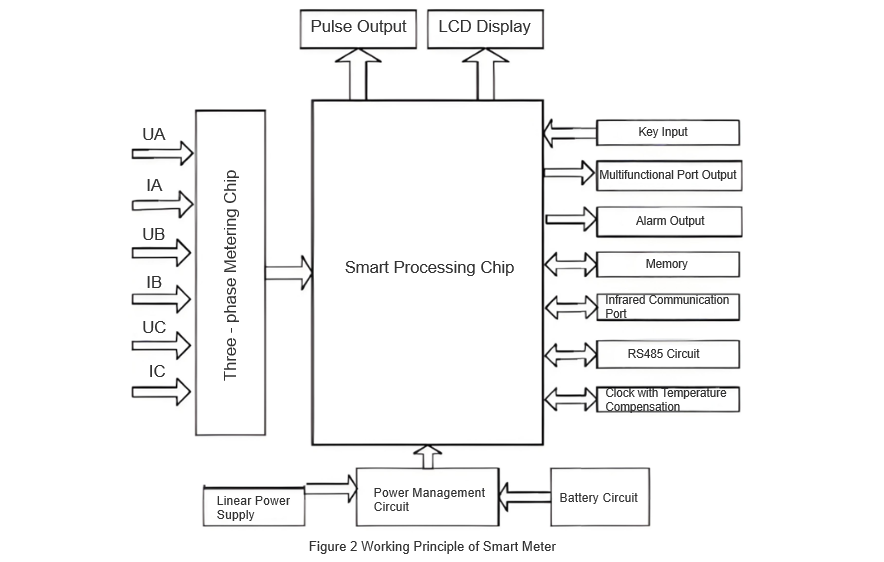Ang pagbasa sa meter, pag-verify, ug pag-bill mahimong kritikal nga operasyon alang sa mga kompanya sa kuryente, ug ang ilang efisiyensiya direkta mopuli sa sustainable development sa kompanya. Sa nakalabay nga tuig, uban sa widespread adoption sa mga intelligent technologies, gi-promote ug gi-aplikar na ang smart meters sa mga kompanya sa kuryente, nag-drive sa transformation sa mga operasyon sa pagbasa sa meter ug pag-bill. Ang integrated application sa smart meters ug information systems alang sa pagbasa, pag-verify, ug pag-bill naging usa ka key development direction. Kini nagpasabot nga ang mga kompanya sa kuryente kinahanglan mapadako ang ilang pagkaunawa bahin sa smart meters ug related information systems, ug paubos ang integrasyon sa mga meter sa mga information systems.
1. Application Principles of the Integrated Smart System for Meter Reading, Verification, and Billing
Ang core principle sa pag-apply sa integrated smart system mao ang pagsulay sa strengths sa traditional manual management sama sa modern intelligent technologies, sama sa minimization sa human interference sa proseso sa pagbasa, pag-verify, ug pag-bill, aron mas mapabilis ang integrasyon sa smart meters sa information systems. Bagama adunay daghang rehiyon sa China naka-achieve na ang system automation, aron makamit ang full value sa integrated smart system, ang mga kompanya sa kuryente gihapon kinahanglan mag-refine sa mga detalye sama sa electricity billing policies, naglakip sa foundation alang sa mas okupado nga system development. Ang mga kompanya kinahanglan muna moganti sa traditional marketing service concepts, focused sa customer needs, ug mapabilis ang integrated smart system pinaagi sa continuous improvement sa service levels. Tungod sa pag-improve sa standards of living ug marketing concepts, ang automation level sa pagbasa, pag-verify, ug pag-bill naka-increase na. Habang irecord ang relevant data, ang staff kinahanglan mapadako ang system maintenance, maayo nga identify ug resolve issues, ug enhance ang daily inspections aron masiguro ang accuracy sa electricity billing data. Bisan pa, ang actual operation sa meter boxes kinahanglan i-inspect sumala sa regulations sa metering.
2. Functions and Applications of Smart Meters
2.1 Meter Reading Function
Ang meter reading function (see Figure 1) mao ang pinaka-basic nga capability sa smart meters. Ang parehas ang traditional ug smart meters adunay kini nga function, apan ang smart meters adunay mas dako nga advantages. Ang traditional meter reading komplikado, gigikanan sa dedicated personnel aron manual nga irecord ang data on-site. Ang buong proseso gikan sa pagbasa, pag-summarize, data entry hangtod sa computation gihatagan og dako nga pagtumong sa manual labor. Kini nga method dili lang nag-consume og dako nga tawo ug materyales apan susceptible usab sa human error. An unsa nga oversight o mistake sa stage sa pagbasa mao ang maghatag og direktang epekto sa subsequent data processing, posible nga magresulta og substantial financial losses sa power company.

Ang widespread adoption sa smart meters nag-satisfy sa demand sa mga kompanya sa kuryente alang sa remote meter reading, effectively reducing their operational burden in meter reading while significantly improving work efficiency. Ang basic principle sa smart meter involves using an A/D converter or metering chip to collect real-time current and voltage data from users. This data is then analyzed and processed by a CPU to accurately calculate active/reactive, peak/off-peak, or four-quadrant energy consumption. The resulting energy data is output via communication modules or a display unit, as illustrated in Figure 2. The remote reading capability of smart meters enables seamless integration with meter reading, verification, and billing information systems.
Ang remote reading mao ang hallmark advantage sa smart meters, effectively minimizing human interference and delivering more accurate and detailed energy data. Furthermore, supported by smart meters, staff can directly calculate electricity bills by comparing historical data, eliminating the need for manual data verification. Currently, smart meters have been widely deployed in many regions and have gained broad public acceptance. With smart meters, residents can conveniently monitor real-time energy consumption and remaining balance, enabling better household energy management and timely top-ups or bill payments.

2.2 Electricity Billing Monitoring and Calculation
Ang billing monitoring and calculation mao ang key functions sa smart meters, enabling real-time monitoring and accounting of electricity consumption. Pinaagi niining function, ang mga kompanya sa kuryente makapugot sa continuous tracking sa status sa meter, effectively resolving discrepancies between actual usage and billing. Additionally, ang smart meters automatically calculate user electricity charges. After automatic collection of consumption data, the meter computes the bill based on usage, significantly reducing time spent on manual calculations. In billing settlement, the integration of smart meters with the meter reading, verification, and billing information system fully leverages its advantages, accurately calculating actual consumption and real-time charges in compliance with national policies and regulations.
Ang computer terminals essential for billing monitoring and calculation. Ang primary advantage mao ang high efficiency—billing for an entire prefecture-level city can typically be completed within minutes. Currently, many regions adopt a “smart meter + manual” review approach. Power companies divide their service areas into key and regular zones. For key zones, an initial manual calculation is performed, followed by system data comparison; for regular zones, only a sample is compared. If no errors are found, the system sends notifications via WeChat mini-programs or the user’s registered mobile number.
2.3 Prepaid Function
Ang prepaid service allows users to deposit funds into their electricity accounts in advance. In traditional power supply, users could not monitor remaining balance, often leading to disconnection when funds were depleted. With smart meters, users can view their remaining balance in real time. When the balance is low, users can prepay via offline methods, with payments directly loaded onto an IC card. Additionally, users can recharge their IC cards through WeChat, Alipay, or other online platforms.
The widespread adoption of computer and internet technologies has greatly accelerated the integration of smart meters with meter reading and billing systems. Most power companies have partnered with commercial banks and major online payment platforms, and online payment services are now available in most cities nationwide. Online payment eliminates time and space constraints, allowing users to pay bills anytime, anywhere. After linking with a smart meter, users can conveniently check consumption and remaining balance, and services such as cash collection and automatic deduction become feasible. Diversified payment methods not only enhance user convenience but also drive the transformation of meter reading, billing, and collection operations toward a user-centric, integrated service model.
3 Construction of the Integrated Smart System for Electricity Billing
3.1 System Technical Support
Many regions now use smart meters and smart terminals for meter reading, verification, and billing. Analysis of the integrated system reveals it primarily relies on mobile communication, GPS, and infrared meter reading technologies. Staff use PDA handheld terminals to obtain user data for re-reading and anomaly information. The system then assigns meter reading tasks via GPS. After completing readings, staff upload data to the company’s computer terminal, where the database automatically matches information, improving operational efficiency.
Additionally, the system requires technical support for verification and auditing. The intelligent audit system consists of three main modules: strong constraint, audit result fluctuation checking, and alerting. Key considerations during implementation include:
First, “strong constraint” conditions must be added to the calculation process, which is crucial for the constraint module. Power companies must also set parameters such as electricity rates and peak/off-peak pricing to ensure the system generates matching search criteria and enables clear decision-making. When data violates rules, the system automatically splits or rolls back the transaction, reissuing only after detailed system checks are passed.
Second, alert conditions matching real-world scenarios must be set to activate the alert module. Power theft often causes data anomalies. When the system detects such anomalies during comparison, it automatically sends alerts to staff along with detailed information, enabling timely investigation.
Finally, the system can provide visual prompts (e.g., color-coded backgrounds) for users with service changes, helping prevent operational errors.
3.2 Establishing a Matching Business Monitoring Platform
The business monitoring platform is supported by computer and big data technologies, enabling alignment of process data and workflow nodes to build a comprehensive monitoring system for meter reading and billing. The platform’s architecture includes:
The overall structure comprises a data management system, application management system, interface service system, file service system, and business support system. It integrates mobile communication, internet, and GPS technologies to comprehensively manage and monitor business operations such as grid-customer integration and meter reading, verification, and billing, significantly improving process handling, inter-departmental coordination, and business integration.
The application architecture consists of three layers: presentation, business, and data.
The presentation layer handles data acquisition, exception handling, alarms, data reception, and feedback, essentially serving as a web front-end and mobile terminal visualization interface.
The business layer meets data storage needs, managing work orders, on-site meter reading operations, GPS tracking, and data transmission/reporting.
The data layer, while similar to the business layer in being data-centric, handles more detailed tasks such as data maintenance, work order sources, and system configuration.
Security architecture is also critical. During system development and deployment, power companies must balance usability with reliability and security, minimizing risks of security incidents.
The system typically features high MTBF (Mean Time Between Failures) and low MTTR (Mean Time To Repair), providing robust fault tolerance. It can automatically detect fault locations, identify causes, and initiate recovery. In the event of network or system failures, the platform can also provide matching disaster recovery services.
4 Conclusion
In summary, during their development, power companies should recognize the value of integrating smart meters with meter reading, verification, and billing systems. Smart meters not only reduce staff workload but also ensure data accuracy, significantly improving operational efficiency. Therefore, power companies should actively transform their operational mindset, continuously enhance their service capabilities, and promote the evolution of meter reading and billing operations toward integration and intelligence.
























